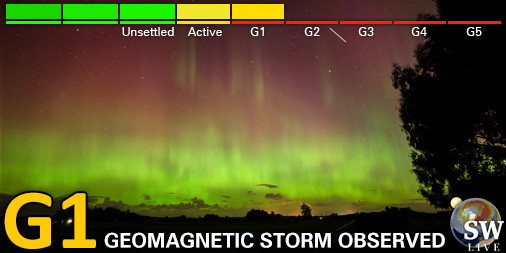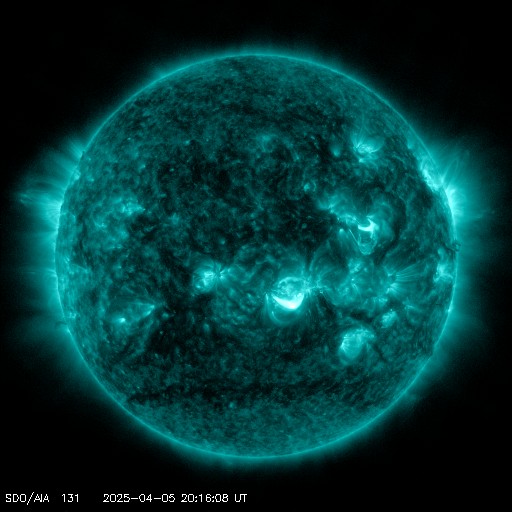Viewing archive of Saturday, 14 February 2015
Daily bulletin on solar and geomagnetic activity from the SIDC
Issued: 2015 Feb 14 1253 UTC
SIDC Forecast
Solar flares
Quiet conditions (<50% probability of C-class flares)
Geomagnetism
Quiet (A<20 and K<4)
Solar protons
Warning condition (activity levels expected to increase, but no numeric forecast given)
| 10cm flux | Ap | |
|---|---|---|
| 14 Feb 2015 | 120 | 003 |
| 15 Feb 2015 | 119 | 002 |
| 16 Feb 2015 | 120 | 001 |
Bulletin
Over the past 24 hours there were a couple of B class flares, just above the background flux. Most activity occurred in (Active Region) AR 2282 currently located close to the center of the solar disk (N10). There were no significant flares recorded over the past 24 hours. Previously active NOAA AR 2280 has moved over the Western hemisphere limb. NOAA AR 2284 has rotated into view on the Eastern hemisphere. NOAA ARs 2281, 2282 and 2284 appear stable, with small amounts of flux emergence. AR 2283 which emerged near disk center on 2015-Feb-12 has remained small and appears stable. There is a large filament located between S40W10 and S10W90, however this has remained, and appears, stable. Flaring is expected to continue at the B-class level with a possibility of C-class flares. There were no Earth directed CMEs. Proton numbers have been slowly growing over the last 24 hours. The solar wind speed has remained stable over the past 24 hours around 320 km /s. The total magnetic field has been stable around 6 nT, and the Bz component has fluctuated from positive to negative. The Bz has ranged between +6 and -4 nT over the past 24 hours. Geomagnetic conditions were quiet to moderate over the past 24 hours (NOAA Kp 0-1, local K Dourbes 0-2). A large transient coronal hole is currently centered at W35, this may produce enhanced solar wind speeds. Solar wind conditions have been quiet, which is expected to persist. Geomagnetic conditions are expected to be quiet to unsettled with an isolated active period possible.
Today's estimated international sunspot number (ISN): 043, based on 09 stations.Solar indices for 13 Feb 2015
| Wolf number Catania | /// |
| 10cm solar flux | 125 |
| AK Chambon La Forêt | 006 |
| AK Wingst | 002 |
| Estimated Ap | 002 |
| Estimated international sunspot number | 045 - Based on 22 stations |
Noticeable events summary
| Day | Begin | Max | End | Loc | Strength | OP | 10cm | Catania/NOAA | Radio burst types | |
|---|---|---|---|---|---|---|---|---|---|---|
| None | ||||||||||
Provided by the Solar Influences Data analysis Center© - SIDC - Processed by SpaceWeatherLive
All times in UTC
Current data suggests there is a slight possibility for aurora to appear at the following high latitude regions in the near future
NorilskLatest news
Latest forum messages
Support SpaceWeatherLive.com!
A lot of people come to SpaceWeatherLive to follow the Sun's activity or if there is aurora to be seen, but with more traffic comes higher server costs. Consider a donation if you enjoy SpaceWeatherLive so we can keep the website online!

Latest alerts
Sunday, 6 April 2025
02:00 UTC - Geomagnetic activity
Minor G1 geomagnetic storm (Kp5) Threshold Reached: 01:50 UTC
Saturday, 5 April 2025
20:30 UTC - Geomagnetic activity
Minor G1 geomagnetic storm (Kp5) Threshold Reached: 20:20 UTC
20:24 UTC - Solar flare
Moderate M1.05 flare
20:09 UTC - Radio Blackout
Minor R1 radio blackout in progress (≥M1 - current: M1.05)
Space weather facts
| Last X-flare | 2025/03/28 | X1.1 |
| Last M-flare | 2025/04/05 | M1.0 |
| Last geomagnetic storm | 2025/04/06 | Kp5 (G1) |
| Spotless days | |
|---|---|
| Last spotless day | 2022/06/08 |
| Monthly mean Sunspot Number | |
|---|---|
| March 2025 | 134.2 -20.4 |
| April 2025 | 148.7 +14.5 |
| Last 30 days | 132.7 -9.9 |





